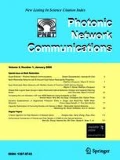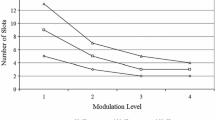Abstract
Analytical blocking probability analysis is important for network design. In this paper, we present an analytical model for the blocking probability analysis on adaptive routing over the WDM networks with finite wavelength conversion capability. Modeling the finite nature of wavelength conversion has been a difficult task. We make use of the idea of segmented route to handle the finite wavelength conversion property. In this approach, a route is divided into a number of segments separated by wavelength converting nodes. We then combine the single-link model and the overflow model to derive the network-wide blocking probability. There are two distinct features in our technique. First, a concept of segmented route is used. Second, link state is considered when calculating the traffic flow. The latter ensures that the analytical results match closely to practical network status. Extensive simulations show that the analytical technique is effective in modeling the blocking probability performance for sparse networks.
Similar content being viewed by others
References
Girard, A.: Routing and Dimensioning in Circuit-Switched Networks. Addison-Wesley (1994)
Karasan E., Ayanoglu E. (1998): Effects of wavelength routing and selection algorithms on wavelength conversion gain in WDM optical networks. IEEE/ACM Trans. Networking 6(2): 186–196, (April)
Subramaniam S., Somani, A.K., Azizoglu, M., Barry, R.A.: A performance model for wavelength conversion with non-poisson traffic. Proc. of IEEE INFOCOM ‘97, vol. 2, pp. 499–506. Kobe, Japan (1997)
Sahin G., Azizoglu M. (1998) Multicast routing and wavelength assignment in wide area networks. Proc. of SPIE Conference on All-Optical Networking: Architecture, Control, and Management. SPIE 3531, 196–208, (Nov)
Mokhtar A., Azizoglu M. (1998) Adaptive wavelength routing in all-optical networks. IEEE/ACM Trans. Networking 6(2): 197–206
Birman A. (1996) Computing approximate blocking probabilities for a class of all-optical networks. IEEE J. Selected Areas Commun. 14(5): 852–857, (June)
Hsu C.-F., Liu, T.-L., Huang, N.-F.: Performance of adaptive routing strategies in wavelength-routed networks. Proc. IEEE International Conference on Performance. Computing and Communications, pp. 163–170. Phoenix, Arizona, USA (2001)
Ramamurthy B., Mukherjee B. (1996) Wavelength conversion in WDM networks. IEEE J. Selected Areas Commun. 16, 1061–1073, (Sept)
Ding, A., Poo, G.-S., Tan, S.-T.: An expanded graph model for MCRWA problem in WDM networks. Proc. of IEEE LCN02, pp. 557–564. Tampa, FL, USA, (Nov. 2002)
Author information
Authors and Affiliations
Corresponding author
Rights and permissions
About this article
Cite this article
Poo, GS., Ding, A. Blocking performance analysis on adaptive routing over WDM networks with finite wavelength conversion capability. Photon Netw Commun 12, 211–218 (2006). https://doi.org/10.1007/s11107-006-0032-3
Received:
Revised:
Accepted:
Published:
Issue Date:
DOI: https://doi.org/10.1007/s11107-006-0032-3




